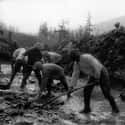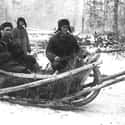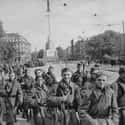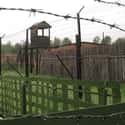-
(#5) The Gulag Was A Slave Labor Front
During interrogation, anyone who was arrested was often given bogus reasons for their arrest. These absurd reasons included the usual list of treasonous acts like spying, economic sabotage, anti-revolutionary activity, or - after the 1930s - being sympathetic to enemies of the state such as the Kulaks. While these were some of the reasons given, they masked the true reason that many people were arrested: their economic value.
After Joseph Stalin initiated his five-year plan to rapidly modernize the Soviet Union, the government needed laborers to work on huge construction and industrial projects. It also quickly realized that there was a lack of knowledgeable and skilled specialists. So a steady stream of arrests and the deportation of hundreds, then thousands, of people year after year fed the Gulag, which then, with the aid of its slave labor, built Stalinist Russia.
Gulag camp guards had control over every aspect of a prisoner's existence. If a guard was in a good mood or bad mood, that could determine how much a prisoner ate, what clothes they could wear, and where they slept.
-
(#9) Camp Living Conditions Provided Almost No Basic Needs
Daily life in the camps was reflective of the seasons and geographic locations of the Gulags. For example, camps north of the Arctic Circle were bleak most of the time while camps close to the Chinese border were a bit more tolerable (weather-wise, that is).
All camps, however, had hard labor, very little food, disease, a lack of basic amenities, and the constant threat of death in common. Barracks were often nothing more than wooden shacks, and the only clothing that was issued to prisoners were padded jackets and, if you were lucky, trousers, caps, and mittens. Food was bland and infrequent, and, because of the lack of nutrition, diseases and work accidents were common causes of injuries and death.
-
(#13) If You Wanted To Escape, You Had To Go To Finland Or China
Escape from the Gulag was no easy feat. Not only did you have to make it past guards and Gulag gangs, but you also had to trek through harsh climates to countries that wouldn't extradite you. There were only two of those: Finland and China. However, a few notable individuals did escape. One story, about a Polish army officer who escaped and crossed the Himalayas to India on foot was made into a film, The Way Back. However, the veracity of this story is disputed.
A verifiable escape did occur in 1933 when Vladimir Tchernavin, his wife Tatiana, and their son Andrei managed to slip away out of Russia and take refuge in Finland. After brief incarceration, Tchernavin was transferred to Karelia near the Finnish border because of his fisheries knowledge. While there, Tchernavin met a local peasant who explained that the camp guards had "a beat of 15 kilometers and they patrol it in pairs. When two return two others start out. Mostly they lie around and listen to the radio. They don’t like to go in the woods. They’re afraid. It is said that there are escaped convicts there who will lie in wait for them and kill them." With this useful insight, Tchernavin began contemplating escape.
In 1931, because of good behavior, Tchernavin’s wife and son were allowed to visit him. Immediately he and Tatiana put escape plans into motion using written code in letters to each other. Towards the end of the summer in 1933, the Tchernavin family were able to slip away from the Gulag camp guards during a visit. On foot and by a boat hidden prior to escape, they fled to Finland. According to Tchernavin, they crossed rivers, forests, and mountains with few provisions, camping in the wilderness to avoid detection.
All three survived, and once they were safe in Finland, they emigrated to England.
-
(#11) Prisoners Were Sent To The WWII Battlefront To Atone For Their Crimes
During WWII, Stalin and Vyacheslav Molotov issued Order No. 227, in which one particular clause transferred Gulag prisoners to special penal battalions in the Red Army to serve on the Eastern Front. The penal battalions were assigned the most dangerous missions to "atone" for their crimes.
An example of this dangerous work was to cross a minefield to clear it of explosives by sacrificing yourself so that regular battalions could safely cross over afterward. Placed behind the penal battalions were blocking units, groups of soldiers whose orders were to fire on anyone retreating.
On some level, even Stalin must've understood the abject craziness of this dictum, seeing as he wouldn't let it be put into print and had it disseminated solely by word of mouth instead.
-
(#3) Arrests and Deportations To The Camps Occurred Everywhere, All The Time
The long journey that led to incarceration in a Gulag prison camp began with arrests almost anywhere and for reasons that ranged from the offensive to the outright absurd.
Descriptions from camp survivors tell tales of being picked up by the NKVD secret police with no notice, no equivalent to the Miranda rights, no rights to an attorney or a trial, and no warrants. This could occur at a sports match, at a restaurant, on the street, at work, or even at home in the middle of the night. The police agents would give someone only a few minutes to gather a few personal possessions. Men, women, and children would then be escorted out to a waiting police van, similar to an armored truck, and locked inside with others. These trucks were called black ravens, as they would spirit the accused away to interrogation in the black of the night.
After interrogation, a person might've spent a night in a prison cell or been immediately locked in a cattle car on a train with others for days while traveling to a Gulag camp. Conditions on the trains were cruel. In the summer, the heat was sweltering, while in the winter, the cold was unbearable. Only a hole in the floor served as a toilet, and the sole food given was salted fish. Many perished from dehydration or froze to death. To make room, their bodies were thrown from the cattle car and left on the side of the railway tracks. And that was just the ride to the Gulag.
-
(#12) Some Survivors Are Still Afraid To Discuss Their Imprisonment
On paper, the Gulag was a prison camp administration, but in practice, the arrests, reasons for incarceration, hard labor, separation from family, executions, and weather all grimly exceeded this simple, bureaucratic designation. They gave this system of "administration" its notorious legacy.
When Stalin passed in 1953, the Gulag held more than 3 million prisoners. Within days of his passing, millions of prisoners had been released, and the new premier, Nikita Sergeyevich Khruschev, began a process of de-Stalinization known as the "thaw."
With Stalin gone, the reality that the camp system was immoral and economically useless led to a period of shrinkage and mass releases of prisoners, many of whom were rehabilitated. However, the trauma it inflicted on its inmates both physically and mentally, from 1918 until Stalin’s passing, left scars on several generations of Russians. Some have survived to this day but are still extremely fearful of discussing their experiences.
New Random Displays Display All By Ranking
About This Tool
Gulag Prison is the most notorious prison system in Soviet history. Prisoners were beaten and tortured there, but some survived. This nauseating and cruel forced labor system was first established after the Russian Civil War. By the 1950s, the labor camps had covered the entire Soviet territory, it can be said one of the darkest periods in the history of the 20th century.
In the Gulag camp, the prisoners did not have safety guarantees or equipment to complete their tasks. They even excavate or build complex projects in cold Siberia only with winter clothes and original tools. It is not surprising that people always die from fatigue and cold. The random tool lists 13 facts about life in Soviet Gulag.
Our data comes from Ranker, If you want to participate in the ranking of items displayed on this page, please click here.
















